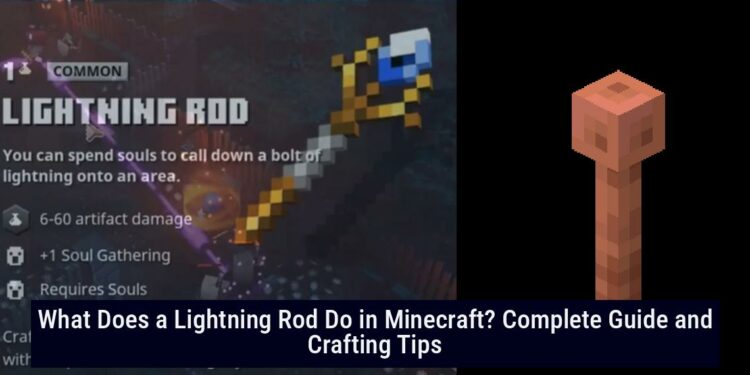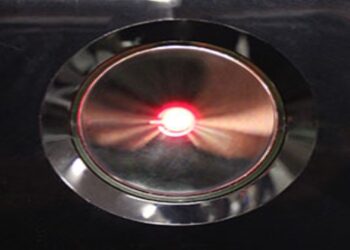Understanding the Function of Lightning Rods in Minecraft
Understanding the Function of Lightning Rods in Minecraft
The primary function of the Lightning Rod is to draw lightning strikes to it instead of something else. It ensures that lightning—which is an uncommon phenomenon that can cause significant damage—hits the rod rather than flammable structures. By placing a lightning rod on top of your structure, you can prevent lightning from hitting it and starting a fire. The lightning rod will absorb the lightning and redirect it to itself, sparing your precious buildings.
In Minecraft, a lightning rod redirects lightning strikes to itself, preventing damage and fire. Additionally, it emits a redstone signal that can be used to trigger actions like opening doors or launching fireworks. The lightning rod absorbs the lightning and converts its electrical energy into a redstone signal.
Lightning rods can be oriented in different directions. They that are the highest block in the column redirect lightning strikes within a spherical volume having a radius of 128 blocks in Java Edition and 64 blocks in Bedrock Edition. The block emits particles during thunderstorms as an indicator. If multiple lightning rods are in range, the closest to the original location of the strike is chosen.
When struck by lightning, a lightning rod and the block it’s attached to emit a redstone signal for 8 game ticks. However, it should be noted that lightning strikes on lightning rods cannot summon skeleton trap horses. Also, lightning can still start fires nearby, though these fires can be quickly extinguished on non-flammable blocks or by rain. Furthermore, lightning inflicts damage on mobs within a 6×12×6 box centered 4 blocks above the bottom center of the lightning rod block (that is extending 2 below and 9 above).
Interestingly, a lightning rod can be struck by a trident enchanted with Channeling during a thunderstorm or even a normal rainstorm in Bedrock Edition, even if solid blocks above it block rainfall, provided all the blocks are fully transparent (sky light level 15 at rod position). Unlike in real life, a lightning rod doesn’t require a direct connection to ground in order to work.
The Minecraft Lightning Rod is the best way to redirect lightning, which is not only handy if you’d like to protect a wooden Minecraft house, but also if you want to save your Villagers from turning into Witches. Keep in mind that the Minecraft Lightning Rod won’t turn you into a thunder god; it doesn’t spawn lightning, it only redirects incoming bolts.
Here are some examples of its other functions:
- Prevent mobs from transitioning into something more dangerous (e.g., a villager struck by lightning turns into a witch).
- Create mobs on purpose (e.g., put a pig in a tiny space with a Lightning Rod in the middle and wait for it to be struck).
- Remove oxidation from copper blocks (just place the Lightning Rod on top of the copper and wait until it gets hit; the greenish color will disappear).
How to Craft a Lightning Rod: Step-by-Step Instructions
To craft a Lightning Rod in Minecraft, you need to follow these steps:
- Place 3 Copper Ingots in a vertical line on a Crafting Table. This will create a single Lightning Rod.
- You can then place the Lightning Rod wherever you want. Make sure to use a Pickaxe of Stone or higher quality (like Diamond) if you want to pick it back up again.
The Lightning Rod serves multiple purposes:
- It is used to divert lightning strikes during thunderstorms.
- You can place it either vertically or horizontally.
- It redirects lightning strikes that would have hit anywhere in a 32x4x32 area around it, causing them to harmlessly strike the top of the rod.
- When struck by lightning, the Lightning Rod sends a redstone signal, making it useful for redstone circuitry applications.
Once crafted, it’s advisable to stick your Lightning Rod somewhere convenient, such as a rooftop, to ensure safety from electrical assaults.
Area Coverage: How Much Does a Lightning Rod Protect?
In Minecraft, the area coverage of a lightning rod varies between editions:
- In Java Edition, the area covered by the lightning rod has a radius of 128 blocks.
- In Bedrock Edition, the coverage radius is 64 blocks.
Furthermore, it is essential to mount the lightning rod on a block that isn’t flammable, such as stone. This precaution prevents the base and nearby flammable blocks from igniting due to a lightning strike.
On structures less than 30 metres (about 100 feet) high, a lightning rod provides a cone of protection where the ground radius approximately equals its height above the ground.
To achieve complete protection for an area, it is necessary to arrange multiple lightning rods in a grid formation. You should place them up to 64 blocks apart or 32 blocks apart on a pillar of blocks with no part of it.
Optimizing Your Build: Should You Place a Lightning Rod on Your House?
Lightning Rods in Minecraft are designed to redirect Lightning Strikes to a specific spot, so long as they strike within the rod’s range. This is 64 blocks in Bedrock and 128 blocks in Java. The lightning rod does one thing and it does it very well: it will entice any lightning strikes in a small area to hit the rod instead of its original target. The electrical energy contained within is converted to a Redstone signal, and nothing catches fire.
Moreover, lightning rods attract lightning that would have struck within a 64 or 128 block radius, depending on whether you’re playing Bedrock or Java. This prevents fires, explosions, or charged creeper spawns.
Additionally, lightning rods have several uses and benefits in the game, such as:
- Preventing fire damage: Lightning can set fire to flammable blocks, and one of the foremost purposes of the lightning rod is to intercept and divert any lightning strikes that make their way to the ground.
- Producing a Redstone signal when struck, which can be used to power mechanisms.
However, it’s important to note that struck Lightning Rods can still damage mobs around the area and can start fires if mounted on a flammable block. They can be placed both on top of or on the sides of blocks.
Lightning Rod Mechanics: How Does It Work in Minecraft?
Minecraft’s Lightning Rods, as their name implies, are designed to redirect Lightning Strikes to a specific spot. This occurs as long as the strikes are within the rod’s range: 64 blocks in Bedrock and 128 blocks in Java.
Unlike in real life, a lightning rod doesn’t require a direct connection to ground in order to work.
Moreover, they actually work. However, it is important to know that lightning still creates fire around the rod. Therefore, you have to place your rods on blocks that cannot burn.
Redstone Innovations: Utilizing Lightning Rods in Circuits
The lightning rod in Minecraft has four main functions:
- Diverts lightning, preventing fire and damage.
- Serves as an ‘energy source’ in redstone circuits.
- Acts as a versatile building material.
- Prevents lightning-induced effects on mobs.
When a lightning rod is struck by lightning, it emits a redstone signal.
This signal is then sent into the ground, enabling its integration into automatic redstone circuits. Consequently, the lightning rod can be ideally combined with redstone circuits to create various new automated mechanisms and functions within the game.
Moreover, you can use lightning rods instead of redstone dust, which balances gameplay by integrating lightning strikes into circuit designs.
Despite these capabilities, this technique is not commonly utilized by players yet. This indicates a potential area for innovation and experimentation in Redstone engineering.
Lightning Rods in Different Editions: A Comparative Overview
Overview of Minecraft Lightning Rods
A lightning rod is a block used to divert lightning strikes. Lightning rods can be oriented in different directions. They can redirect lightning strikes within a spherical volume, having a radius of:
- 128 blocks in Java Edition
- 64 blocks in Bedrock Edition
When struck by lightning, a lightning rod emits a redstone pulse at level 15 for 8 game ticks (0.4 seconds) and strongly powers the block it’s attached to. However, lightning diverted by a lightning rod can still:
- Start fires nearby
- Inflict lightning damage on mobs within a 6×12×6 box centered 4 blocks above the bottom center of the rod
Mechanics in Different Editions
In Bedrock Edition, a lightning rod can be struck by a trident enchanted with Channeling during thunderstorms, even if solid blocks are above it, provided the blocks are fully transparent. Unlike in real life, a lightning rod doesn’t require a direct connection to the ground to function. Additionally, lightning strikes on lightning rods cannot summon skeleton trap horses.
The range of lightning rods was recently increased from 16 blocks to 32 blocks in Java Edition. In Bedrock Edition, version 1.16.220, lightning rods can now be waterlogged and emit particles when in contact with rain. As of version 1.20.30, the blast resistance of lightning rods has been increased from 3.6 to 6.
Protection Against Lightning Strikes
Lightning rods serve as protective features for villagers and structures. They can be used to protect villagers from lightning strikes by installing them near their homes. This re-routes lightning strikes to the rods, preventing villagers from being transformed into witches when struck.
To protect players and villagers from lightning strikes, they should be within the range of the lightning rod:
- 64 blocks in Bedrock Edition
- 128 blocks in Java Edition
Moreover, lightning rods protect structures by providing a conductive path for lightning to follow. They redirect the electrical charge safely into the ground, thereby preventing damage to the structure. It’s advisable to mount the lightning rod on a block that isn’t flammable, such as stone, to avoid igniting nearby flammable blocks during a strike.
Overall, lightning rods in Minecraft not only serve a functional purpose during thunderstorms but also add an interesting aspect to gameplay. In the Minecraft 1.17 update, the lightning rod was introduced as a new feature, enhancing both protection and harnessing the power of lightning strikes.
Common Misconceptions About Lightning Rods in Minecraft
Common misconceptions about lightning rods in Minecraft stem from a fundamental misunderstanding of their mechanics. Below are some key insights into how these rods operate and the complexities involved:
- Lightning rods relocate the potential fire rather than preventing it completely. A practical solution suggested is to place the rods on non-flammable blocks.
- Interestingly, user ‘my45acp1911’ notes that the mechanics of Minecraft’s lightning rods aren’t the same as actual lightning rods. This adds another level of complexity to the game, challenging players to adapt to the mechanics of the Minecraft universe rather than relying on real-world logic.
- ‘DonJuanDoja’ remarks on the in-depth knowledge required to understand the game’s mechanics, which aren’t explicitly explained. While players do not expect a physics tutorial from Minecraft, such encounters can leave some feeling burnt (pun intended).
- Lightning rods attract lightning strikes within a certain radius, which can prevent damage to structures or mob spawning. When struck, they emit a redstone signal, enabling interesting automation applications.
- When lightning strikes a rod, it does, in fact, prevent fires, explosions, or charged creeper spawns. The rod emits a strong redstone signal for a few seconds after being struck.
- Yet, it’s important to note that lightning rods do not divert lightning created by a Channeling trident thrown at an entity, or lightning summoned by commands. Unlike in real life, a lightning rod doesn’t require a direct connection to ground to function.
- Additionally, lightning strikes on lightning rods cannot summon skeleton trap horses.
- It’s worth mentioning that lightning diverted by a lightning rod can still start fires nearby, although they can be quickly extinguished on non-flammable blocks or by rain. Moreover, lightning inflicts damage on mobs within a 6×12×6 box centered 4 blocks above the bottom center of the lightning rod block, effectively extending 2 blocks below and 9 blocks above.
- In terms of area, lightning rods have a significant radius in Java Edition. The rods can redirect lightning strikes within a spherical volume having a radius of 128 blocks in Java Edition and 64 blocks in Bedrock Edition. Lightning diverted by a lightning rod can still start fires on flammable blocks and inflict damage within a 2 block radius.
These insights highlight the need for better in-game tutorials and education regarding game mechanics to help players navigate these complexities.












